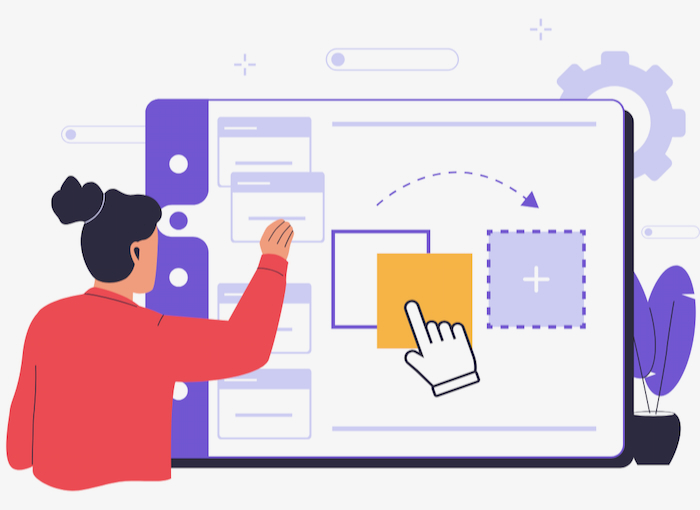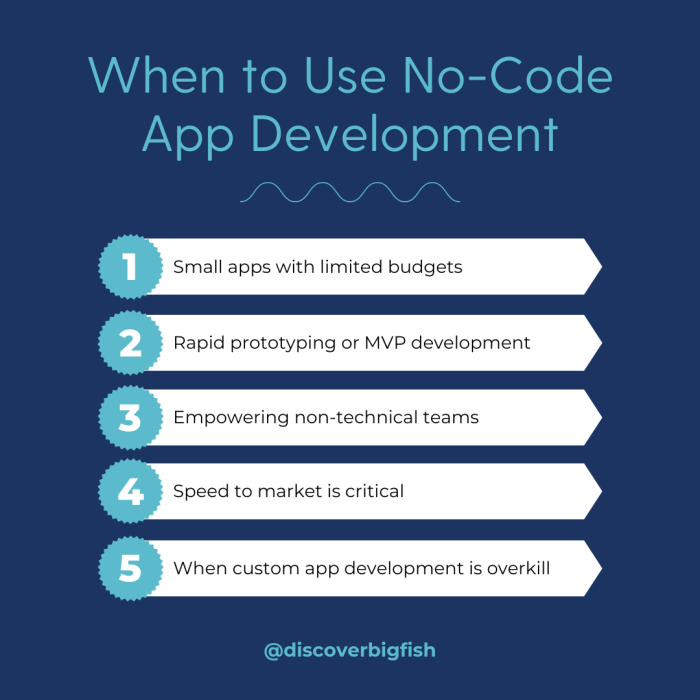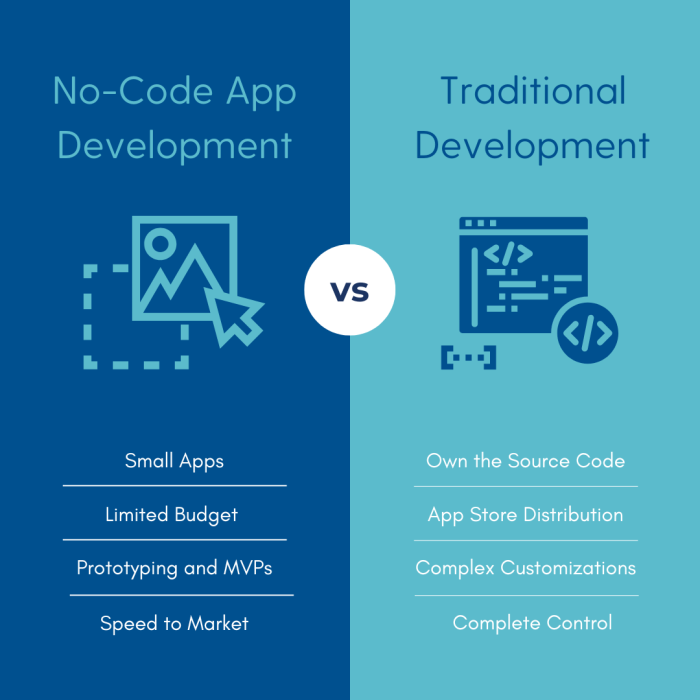As businesses seek faster and more cost-effective ways to develop apps, no-code app development has emerged as an alternative to writing custom code from scratch.
No-code platforms enable non-developers and business users to create functional applications more quickly and at a lower cost than traditional app development. No-code apps can support everything from internal business processes to customer engagement.
In this article, I’ll explore what no-code app development is, when to use no-code app development for your business, the potential limitations and popular no-code platforms to consider.
By the end, you’ll have a clearer understanding of whether no-code development is the right fit for your project.
What is No-Code App Development?
No-code app development allows businesses to build applications without writing any code.
Instead of relying on developers to handcraft every feature and functionality, no-code platforms provide intuitive visual interfaces where users can design, build, and launch apps using drag-and-drop components.
This opens up the app development process to non-technical users, enabling them to create software solutions without needing advanced programming skills.
Users can customize workflows, integrate with other software tools, and build mobile or web applications, all through point-and-click tools.
No-code platforms also come preloaded with templates and pre-configured modules to accelerate the process. This makes it ideal for businesses that need to get simple or generic apps up and running quickly.
No-code platforms empower teams to build apps without writing a single line of code.
For example, companies might use no-code tools to create customer portals, employee management systems, or scheduling tools in a fraction of the time and cost of traditional app development.
However, while no-code platforms simplify the process, they are not suited for every app.
For highly customized, complex, or large-scale solutions that require fine-tuned control over every aspect of the software, businesses may still need traditional development or a hybrid approach that combines no-code with custom code.
When to Use No-Code App Development
Before your business decides between no-code app development, or traditional app development, it’s important to know whether no-code is a good fit for your project.
Here are five scenarios where no-code platforms shine:
1. Small Apps with Limited Budgets
If you’re working on a smaller project with limited financial resources, no-code platforms can offer a cost-effective alternative to custom development.
Hiring a development team for custom coding can be expensive, and no-code tools allow you to launch fully functional apps at a fraction of the cost.
Whether you’re building a simple customer portal or an internal scheduling tool, no-code lets you get started at a lower price point.
2. Rapid Prototyping
When you need to test an idea quickly, no-code development excels at enabling rapid prototyping.
Use no-code app development to quickly validate ideas.
No-code tools allow you to bring your concept to life and validate it with users without committing to a full custom build.
Once the prototype proves successful, you can decide whether to expand it into a more sophisticated app or stick with the no-code solution as it grows.
3. Empowering Non-Technical Teams to Build Internal Tools
One of the major benefits of no-code platforms is that they enable non-technical teams to take ownership of internal app development.
If your operations, HR, or marketing teams need simple tools to facilitate their work, no-code gives them the power to create these apps themselves, without having to rely on developers.
Fun Fact: These non-technical teams who build no-code apps are often called “citizen developers”.
This results in faster turnaround times, less bottlenecking and more flexibility for your business. But keep in mind that no-code is not without a learning curve. I’ll get into that more below.
4. Business Scenarios Where Speed-to-Market is Critical
In fast-paced industries or competitive markets, getting your app to market quickly can be the difference between success and failure.
No-code development dramatically shortens the time it takes to launch an app, allowing you to respond to market demands or operational challenges in real-time.
Whether it’s a customer-facing app or an internal tool to improve productivity, no-code can help you deploy faster.
5. When Custom Development is Overkill
Sometimes, a custom app simply isn’t necessary.
If your app’s requirements are straightforward and don’t involve complex functionalities or unique integrations, no-code can be the smarter choice – even if you have the budget for a custom build.
For example, if you’re creating a generic inventory management system or scheduling app, developing it from scratch might be an inefficient use of resources.
No-code platforms offer the templates you need to build such apps quickly and efficiently, without the added expense or complexity of custom coding.
Limitations of No-Code App Development
While no-code platforms offer speed and accessibility, they aren’t without their limitations.
It’s important to be aware of these potential drawbacks to determine whether no code is the right approach for your project. Here are some key limitations:
1. Lack of Source Code Ownership
Not all no-code platforms allow you to export the source code of the app you build. This can be a critical concern for businesses that want full ownership of their intellectual property (IP).
If your no-code platform doesn’t offer source code export, you may be locked into that platform indefinitely, limiting your ability to scale or modify the app without relying on the provider.
If you plan to sell the IP to your technology in the future, it’s imperative that you own the source code for your app. So this one limitation could be a non-starter.
2. App Store Submission Restrictions
Many no-code platforms are geared toward web applications or internal business tools, which means they may not support submitting apps to public app stores like Apple’s App Store or Google Play.
Not all no-code platforms support app store submissions.
If your goal is to create a customer-facing mobile app, be sure to check whether your chosen platform supports app store submissions, or you may run into significant roadblocks down the line.
3. Steep Learning Curve
While no-code is often promoted as a solution for non-developers, all no-code platforms still come with a learning curve.
Users need time to get comfortable with the platform’s interface, features, and workflows – especially for more complex apps. In some cases, this can require a similar level of effort as learning to code.
4. Limited Customization Options
No-code tools offer predefined templates and components. Not all of them allow for advanced customization and those that do usually require custom code to achieve it.
No-code platforms speed up development, but limit control over customizations.
If your app needs intricate workflows, unique design elements or extensive third party integrations you will probably need to hire a developer. This can override the benefits of using no-code in the first place.
5. Platform Dependency
Building on a no-code platform means committing to that specific tool. Meaning that once you build on one platform, migrating to another can be impossible without rebuilding the app from scratch.
If the platform changes its pricing, policies, or features, your business could be left at their mercy. That said, the significantly lower cost of no-code development could make this risk a non issue.
While these limitations may seem daunting, they don’t have to be a roadblock. By partnering with an app development company like Big Fish, you can avoid the complexities of navigating no-code platforms on your own.
We’ll help you select the right platform for your project – whether that involves source code ownership, app store submissions or heavy customization.
Popular No-Code Development Platforms
1. Bubble
Bubble is a no-code platform for building fully functional web applications without writing code.
However, it doesn’t offer native app development or app store submission, though you can use third-party wrappers such as Phonegap. Bubble also doesn’t allow users to export the source code, meaning you’re tied to their platform.
Bubble is ideal for apps that will be used within a web browser. It works well for startups or businesses building MVPs, internal tools, or customer portals with moderate customization needs.
| Bubble | |
|---|---|
| Code Export | No |
| App Type | Progressive Web Apps (PWAs) only |
| Customization | Moderate |
| App Store Submission | No |
| Best Use Cases | MVPs, internal tools, customer portals |
2. Glide
Glide is designed for quickly creating web apps using data from Google Sheets, and it excels at building simple internal tools or business apps with minimal customization.
It doesn’t offer full native app functionality, but it works well for progressive web apps (PWAs) and can be published as mobile apps via third-party wrappers.
Glide does not provide source code export, making it best suited for straightforward business scenarios where customization is less critical.
| Glide | |
|---|---|
| Code Export | No |
| App Type | Progressive Web Apps (PWAs), mobile apps via third-party wrappers |
| Customization | Minimal |
| App Store Submission | With third-party wrappers |
| Best Use Cases | Simple internal tools, business apps |
3. Flutter Flow
Flutter Flow stands out by allowing users to build both web and native apps (iOS and Android) with greater customization options than many no-code platforms. It offers more flexibility in app design and logic but advanced customization comes with a very steep learning curve.
Notably, Flutter Flow allows you to export your app’s source code, giving you more control over future scalability. It’s ideal for businesses that want native apps and some degree of ownership over their app.
| Flutter Flow | |
|---|---|
| Code Export | Yes |
| App Type | Native (iOS, Android) and Web |
| Customization | High |
| App Store Submission | Yes |
| Best Use Cases | Native apps with more control and scalability |
4. Salesforce
Salesforce’s no-code platform, part of its broader ecosystem, is geared toward enterprise-level apps.
It integrates deeply with the Salesforce CRM and offers extensive customization within that environment. While Salesforce supports progressive web apps and can handle complex workflows, it is not a native app development platform.
Source code export isn’t available, but its power lies in creating robust internal tools, especially for companies already using Salesforce. The learning curve for Salesforce is pretty steep and you will most likely need to hire an experienced Salesforce developer or admin for your project.
| Salesforce | |
|---|---|
| Code Export | No |
| App Type | Progressive Web Apps (PWAs) |
| Customization | Extensive (within Salesforce ecosystem) |
| App Store Submission | No |
| Best Use Cases | Enterprise-level internal tools, Salesforce integration |
Comparison Table of No-Code Platforms
Here is a features comparison for each no-code platform I covered above.
| Platform | Code Export | App Type | Customization | App Store Submission | Best Use Cases |
|---|---|---|---|---|---|
| Bubble | No | Progressive Web Apps (PWAs) only | Moderate | No | MVPs, internal tools, customer portals |
| Glide | No | Progressive Web Apps (PWAs), mobile apps via third-party wrappers | Minimal | With third-party wrappers | Simple internal tools, business apps |
| Flutter Flow | Yes | Native (iOS, Android) and Web | High | Yes | Native apps with more control and scalability |
| Salesforce | No | Progressive Web Apps (PWAs) | Extensive (within Salesforce ecosystem) | No | Enterprise-level internal tools, Salesforce integration |
Final Thoughts on No-Code App Development
No-code app development offers a powerful way to bring business applications to life quickly and affordably, but it’s not a one-size-fits-all solution.
By understanding the limitations – such as platform dependency, restricted customization, and the learning curve – you can make informed decisions about when to use no-code app development for your business.
While no-code simplifies development, complex apps may still require custom coding. Share on XIf this seems overwhelming, working with a development partner like Big Fish can simplify the process. We help you choose the right platform, handle complex integrations and write the code needed for your advanced customizations.
With Big Fish, you get the benefits of no-code without the steep learning curve – allowing you to focus on running your business while we handle the technical details.
Reach out today for a no-charge discovery call and let Big Fish help you choose the best app development solution for your business needs.









